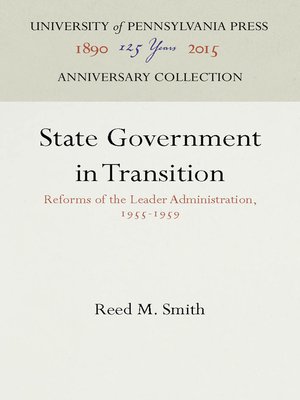State Government in Transition
ebook ∣ Reforms of the Leader Administration, 1955-1959 · Anniversary Collection
By Reed M. Smith

Sign up to save your library
With an OverDrive account, you can save your favorite libraries for at-a-glance information about availability. Find out more about OverDrive accounts.
Find this title in Libby, the library reading app by OverDrive.



Search for a digital library with this title
Title found at these libraries:
| Library Name | Distance |
|---|---|
| Loading... |
This book offers a case study of the George M. Leader administration in Pennsylvania, 1955-1959, with particular reference to the administrative rather than the political changes that took place during that period.
Governor Leader was more active in the reorganization of the central staff services in Pennsylvania than any governor since the 1920s.The most significant changes resulted from the establishment of an Office of Administration within the governor's office. This department embraced a number of staff and operating functions including central budgeting and program evaluation. Over half the text is concerned with the new function of program evaluation, which the Leader administration treated as a basic administrative process, requiring a structure and identity separate from that of the other staff functions.
The author also discusses the traditional nature of the governorship in Pennsylvania, noting the changes that took place as a result of the political and administrative transition in 1955. These changes were in the form of personnel brought into the state service at all levels, the extension of civil service by executive order, the use of patronage, removal power, executive clemency, and other fiscal and personnel reforms.
Other significant stare issues discussed by the author include the use of advisory groups, the nature of the governor's cabinet and staff, the role of "egg heads" in government, the merit system and its extension in a strong patronage situation, and fiscal policy.
State Government in Transition is not only a valuable addition to the literature on state government; it is also a book of great practical value—particularly for the political scientist, student, government worker, or politician.
An appendix with a comparative chart of the governors of Pennsylvania under the Constitution of 1874, which is still in effect, and an organizational chart of the governor's office in 1960 supplement the text.







